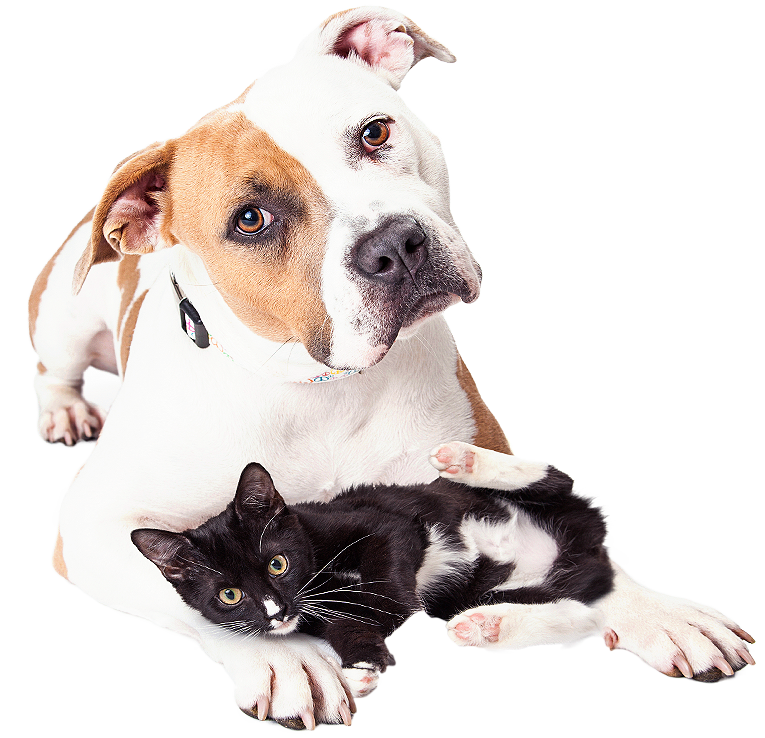Some pet owners feel it’s cruel to spay or neuter their pets. But the truth is, spaying and neutering can protect your furry friend in the long run and help them lead a long and healthy life. Our veterinarians can safely spay and neuter in Santa Ana‘s Affordable Animal Hospital.
Spay and Neuter
Santa Ana

What Does it Mean to
Spay & Neuter a Pet?
Dogs and cats often become sexually mature very early (4 months in cats and 6-12 months in dogs). From the time they’re sexually mature, they experience a rush of hormones during the times when they are in heat and ready to breed, causing them immense discomfort. Often, this sexual maturity makes your pet dog or cat more vulnerable to reproductive diseases like cancer. One way to protect your pet is to get them spayed or neutered.
Spaying is the process of surgically removing the reproductive system of a female cat or dog. Neutering is the process of removing the testicles of a male cat or dog. When your pet is spayed or neutered, he/she is sterilized and cannot have pups or kittens.
Sterilization Can Manage Your Pet’s
Physical Health & Behavior.
Spaying
Spaying protects female cats and dogs from:
- Uterine infections
- Breast cancer
- Immunodeficiency viruses
- Pyometra bacterial infections
- Ovarian cancer and uterine tumors
- Permanent damage to the birth canal while giving birth
- Fatalities giving birth
Neutering
Neutering protects male cats and dogs from:
- Testicular cancer
- Prostate cancer
- Perianal tumors
- Perineal hernias
- Uncontrolled urine marking
Since sterilization controls the hormonal balance in your pet, he/she won’t display any aggression that they typically do when in heat. Additionally, they won’t yowl, caterwaul, bark or whine incessantly and will be calmer and happier.
When Should You Spay or Neuter Your Pet?
The ideal age for spaying and neutering your pets is between 6 to 9 months old. However, some pet parents get their pets neutered when they are as young as 8 weeks old. Consult our team at Affordable Animal Hospital Santa Ana to find out when to get your pet sterilized.
Spaying & Neutering Processes That We Follow at Affordable Animal Hospital Santa Ana
At Affordable Animal Hospital Santa Ana, we start by doing a comprehensive medical evaluation of your pet. Next, we anesthetize your pet and insert a breathing tube. We then start the surgery.
When spaying your female cat or dog, we make a small incision just above your pet’s navel. We carefully remove the reproductive system, which includes the ovaries, fallopian tubes, and uterus. We suture the navel and close-up your pet. The body will later absorb these medical-grade sutures.
While neutering your male dog or cat, we make a tiny incision at the base of your pet’s scrotum. The testicles are gently lifted out and the scrotum is stitched into place. We use dissolvable, medical-grade sutures for the procedure.
It can take about 20 to 90 minutes to spay your female pet. However, neutering takes just between 5 to 20 minutes.
Combating Pet Overpopulation with Medical Intervention
Not only does sterilization keep your pet healthy, but it also reduces the problems of overpopulation.
Did you know that a single unspayed female dog can have up to 3 litters in a year, with each litter having 7 pups? Similarly, a female cat can have up to 3 litters per year with up to 4 kittens in each litter. We’re not even counting the number of females an unneutered cat or dog can breed with, while in heat. Imagine how many pups and kittens they can have from each litter in their lifetimes if they’re unspayed and unneutered.
Spaying and neutering of pets allow pet parents to control the population of pets at home. It also helps them provide their furry babies with the care, nutrition, and love they deserve to lead long, happy, and healthy lives.
Helping Your Pet Recovery After the Surgery
Your cat or dog will feel sore after the surgery. You must stop them from licking or biting at the surgical site. It will take about 10 to 12 days for the stitches to heal. It’s recommended that your pet avoids any physical activity during this time. Lay them inside a crate so they don’t move around too much and stretch the stitches. Be sure to use the medications our vets prescribe and bring your pet for a post-surgical evaluation, if necessary.
Debunking the Myths Surrounding Pet Sterilization
Here are a few myths that you should not believe about spaying and neutering pets:
Spaying & neutering is painful
Anesthesia is used during surgery and pain-free soft sutures are used to stitch-up the skin. Medication is prescribed after the treatment. Together, these help your pets feel comfortable.
Pets always put on weight after getting sterilized
In some breeds, metabolism slows down after spaying/neutering and they may put on weight. But you can easily manage their weight through diet and exercise.
Pets can’t be spayed/neutered when they’re in heat
You can sterilize your pet when he/she is in heat, but they may be more sensitive to post-surgical bleeding or infections at this time. It’s recommended that you wait to prevent complications.
Pets’ personality is affected when you spay/neuter them
Your pet’s ability to be affectionate or protective or enthusiastic does not depend on sterilization. Spaying/neutering will improve their overall health.
Contact Affordable Animal Hospital for more information, or if you already know you need a vet that will spay and neuter in Santa Ana.
Affordable Animal Hospital
1901 N. Broadway
Santa Ana, Ca 92706
Tel:
(714) 942-2986
Hours:
Mon: Closed
Tue-Fri: 9am to 6pm
Sat-Sun: 9am to 2pm

